Analysis of a Turnaround Using the Excellence Model: M08 Report
VerifiedAdded on 2022/08/26
|26
|6795
|17
Report
AI Summary
This report analyzes a plant turnaround, using the Turnaround Model of Excellence, based on a plant manager's report from July 2016. The analysis focuses on five key elements: organization, planning, costs, logistics, and execution. The report delves into the challenges and successes of the turnaround, examining the shutdown process, the implementation of strategies, and the impact on costs and employee management. It critiques the firm's approach to these elements and identifies areas for improvement, offering recommendations for future turnarounds. The report also includes a case study analysis, highlighting the controversial aspects of the process and the impact of delays and costs. Overall, the report provides a comprehensive review of the turnaround, evaluating the firm's performance and offering insights into effective turnaround management.

Turnaround Model of Excellence 1
Name of the Class
Professor
Name of the School
City and State
Date
Name of the Class
Professor
Name of the School
City and State
Date
Paraphrase This Document
Need a fresh take? Get an instant paraphrase of this document with our AI Paraphraser
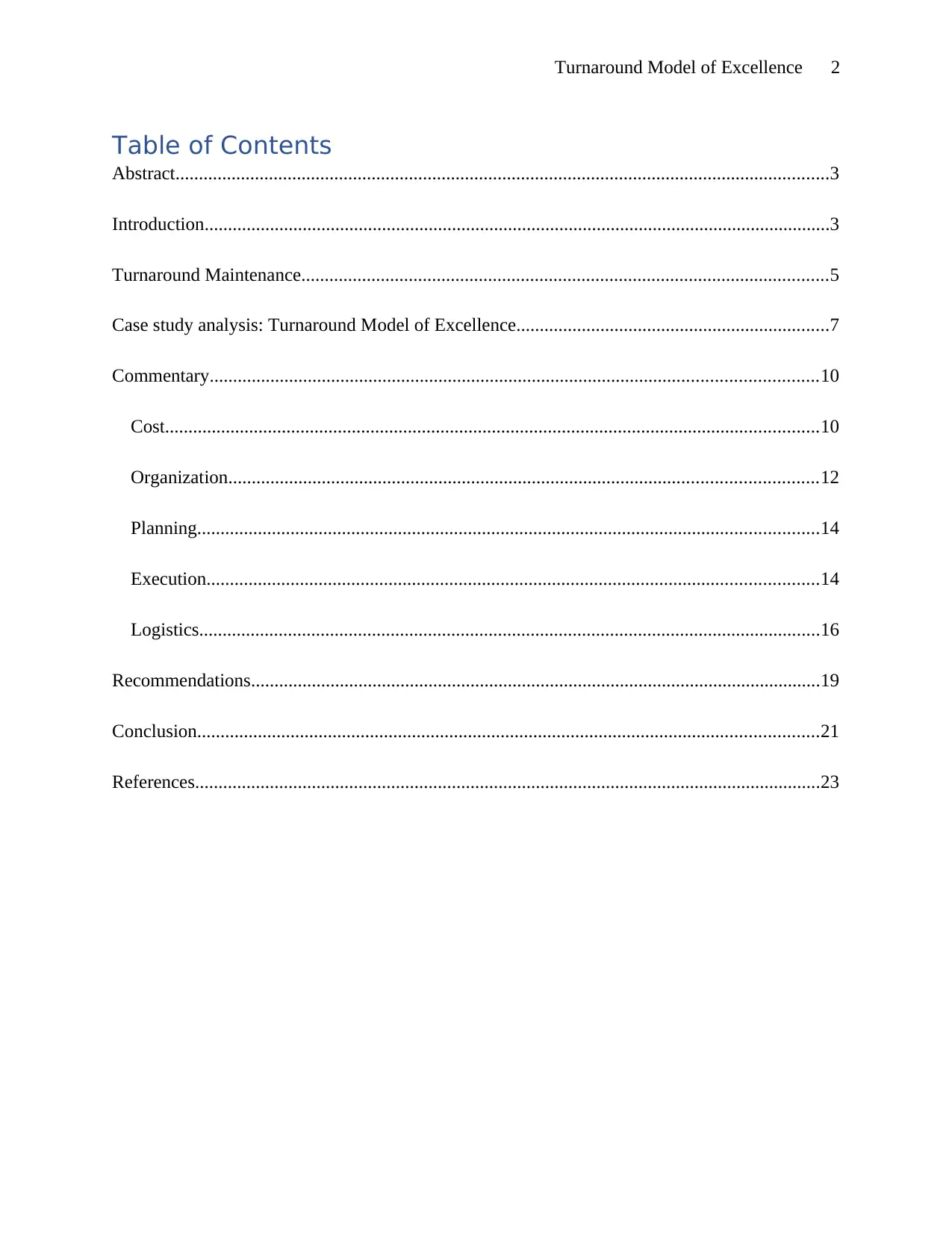
Turnaround Model of Excellence 2
Table of Contents
Abstract............................................................................................................................................3
Introduction......................................................................................................................................3
Turnaround Maintenance.................................................................................................................5
Case study analysis: Turnaround Model of Excellence...................................................................7
Commentary..................................................................................................................................10
Cost............................................................................................................................................10
Organization..............................................................................................................................12
Planning.....................................................................................................................................14
Execution...................................................................................................................................14
Logistics.....................................................................................................................................16
Recommendations..........................................................................................................................19
Conclusion.....................................................................................................................................21
References......................................................................................................................................23
Table of Contents
Abstract............................................................................................................................................3
Introduction......................................................................................................................................3
Turnaround Maintenance.................................................................................................................5
Case study analysis: Turnaround Model of Excellence...................................................................7
Commentary..................................................................................................................................10
Cost............................................................................................................................................10
Organization..............................................................................................................................12
Planning.....................................................................................................................................14
Execution...................................................................................................................................14
Logistics.....................................................................................................................................16
Recommendations..........................................................................................................................19
Conclusion.....................................................................................................................................21
References......................................................................................................................................23
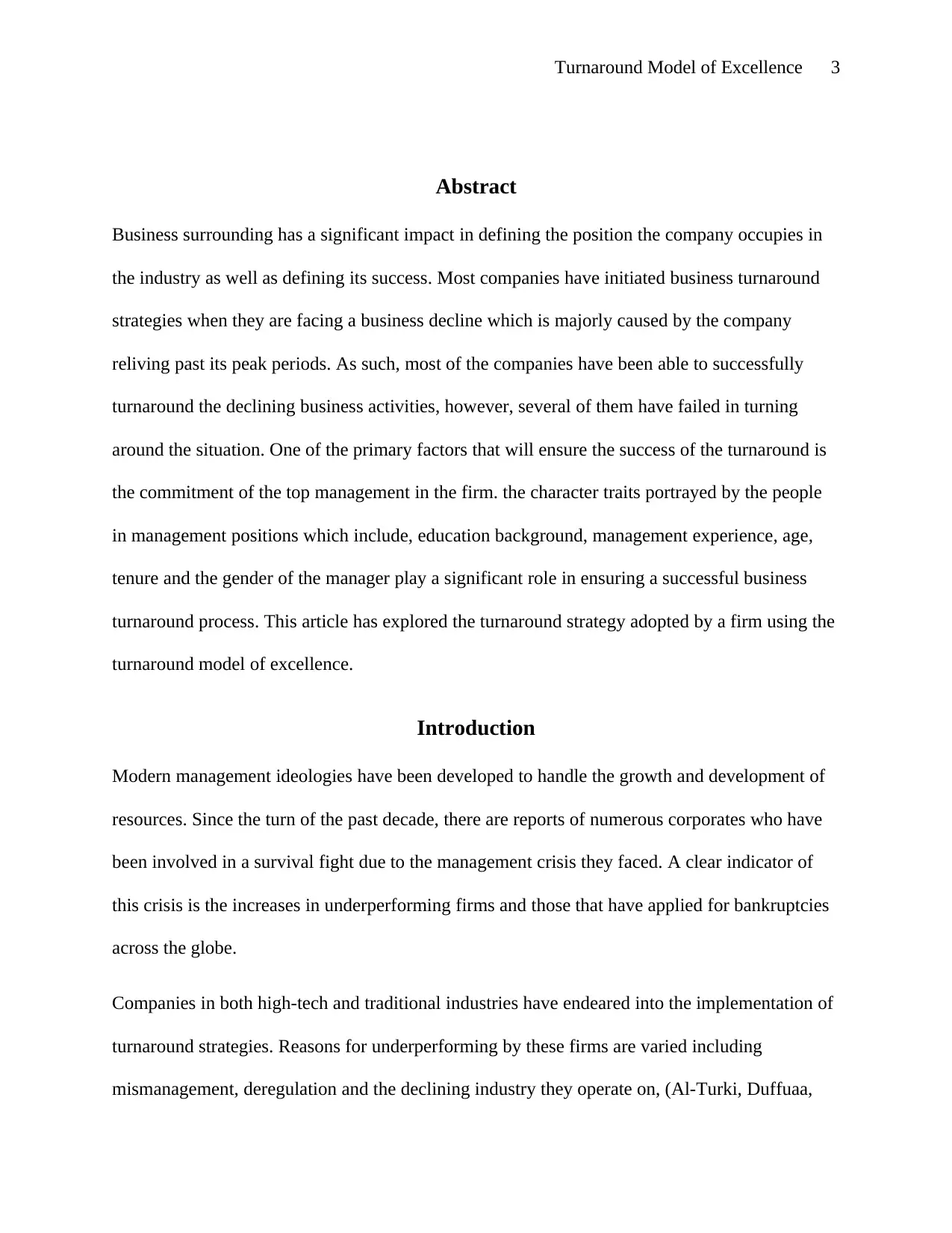
Turnaround Model of Excellence 3
Abstract
Business surrounding has a significant impact in defining the position the company occupies in
the industry as well as defining its success. Most companies have initiated business turnaround
strategies when they are facing a business decline which is majorly caused by the company
reliving past its peak periods. As such, most of the companies have been able to successfully
turnaround the declining business activities, however, several of them have failed in turning
around the situation. One of the primary factors that will ensure the success of the turnaround is
the commitment of the top management in the firm. the character traits portrayed by the people
in management positions which include, education background, management experience, age,
tenure and the gender of the manager play a significant role in ensuring a successful business
turnaround process. This article has explored the turnaround strategy adopted by a firm using the
turnaround model of excellence.
Introduction
Modern management ideologies have been developed to handle the growth and development of
resources. Since the turn of the past decade, there are reports of numerous corporates who have
been involved in a survival fight due to the management crisis they faced. A clear indicator of
this crisis is the increases in underperforming firms and those that have applied for bankruptcies
across the globe.
Companies in both high-tech and traditional industries have endeared into the implementation of
turnaround strategies. Reasons for underperforming by these firms are varied including
mismanagement, deregulation and the declining industry they operate on, (Al-Turki, Duffuaa,
Abstract
Business surrounding has a significant impact in defining the position the company occupies in
the industry as well as defining its success. Most companies have initiated business turnaround
strategies when they are facing a business decline which is majorly caused by the company
reliving past its peak periods. As such, most of the companies have been able to successfully
turnaround the declining business activities, however, several of them have failed in turning
around the situation. One of the primary factors that will ensure the success of the turnaround is
the commitment of the top management in the firm. the character traits portrayed by the people
in management positions which include, education background, management experience, age,
tenure and the gender of the manager play a significant role in ensuring a successful business
turnaround process. This article has explored the turnaround strategy adopted by a firm using the
turnaround model of excellence.
Introduction
Modern management ideologies have been developed to handle the growth and development of
resources. Since the turn of the past decade, there are reports of numerous corporates who have
been involved in a survival fight due to the management crisis they faced. A clear indicator of
this crisis is the increases in underperforming firms and those that have applied for bankruptcies
across the globe.
Companies in both high-tech and traditional industries have endeared into the implementation of
turnaround strategies. Reasons for underperforming by these firms are varied including
mismanagement, deregulation and the declining industry they operate on, (Al-Turki, Duffuaa,
⊘ This is a preview!⊘
Do you want full access?
Subscribe today to unlock all pages.

Trusted by 1+ million students worldwide
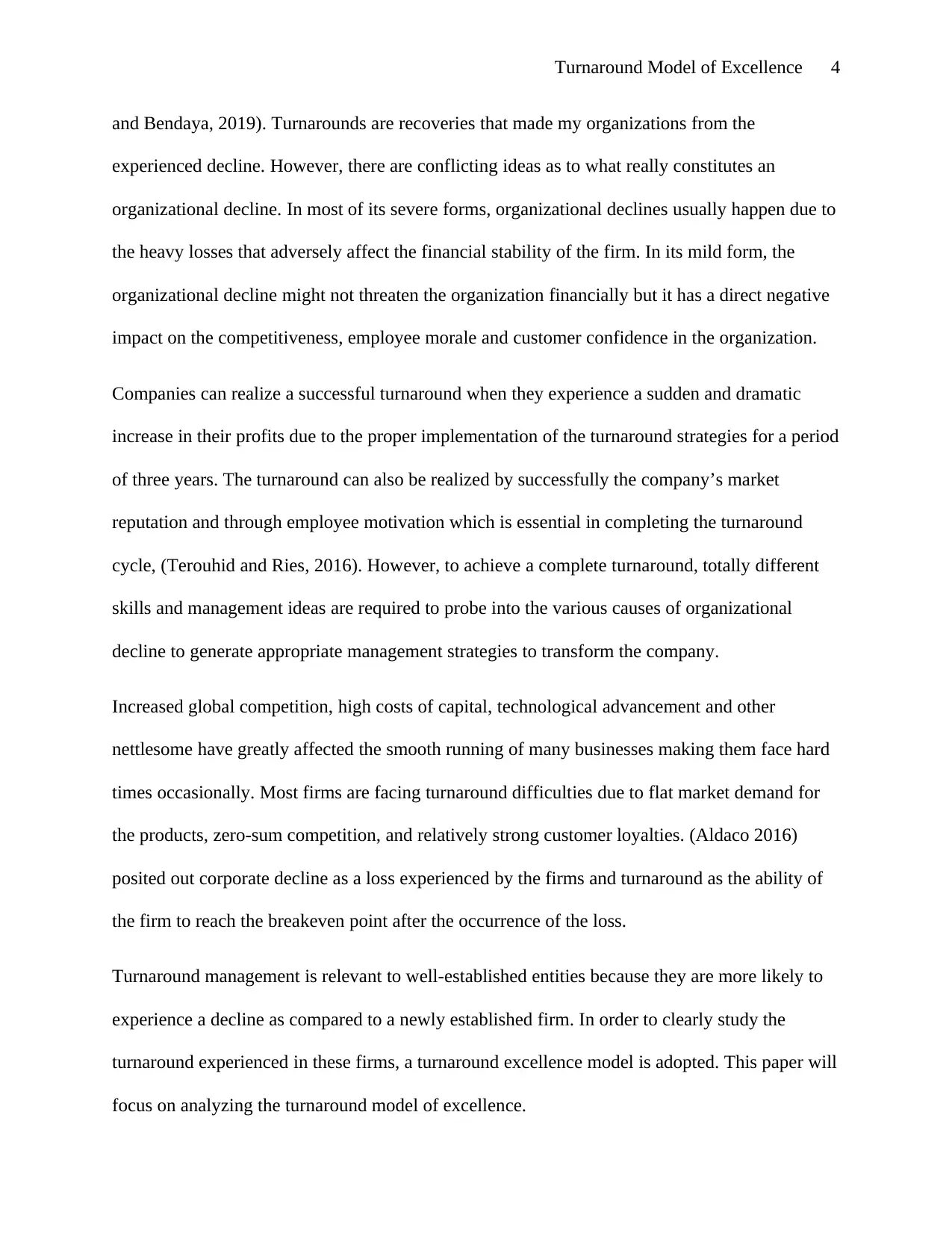
Turnaround Model of Excellence 4
and Bendaya, 2019). Turnarounds are recoveries that made my organizations from the
experienced decline. However, there are conflicting ideas as to what really constitutes an
organizational decline. In most of its severe forms, organizational declines usually happen due to
the heavy losses that adversely affect the financial stability of the firm. In its mild form, the
organizational decline might not threaten the organization financially but it has a direct negative
impact on the competitiveness, employee morale and customer confidence in the organization.
Companies can realize a successful turnaround when they experience a sudden and dramatic
increase in their profits due to the proper implementation of the turnaround strategies for a period
of three years. The turnaround can also be realized by successfully the company’s market
reputation and through employee motivation which is essential in completing the turnaround
cycle, (Terouhid and Ries, 2016). However, to achieve a complete turnaround, totally different
skills and management ideas are required to probe into the various causes of organizational
decline to generate appropriate management strategies to transform the company.
Increased global competition, high costs of capital, technological advancement and other
nettlesome have greatly affected the smooth running of many businesses making them face hard
times occasionally. Most firms are facing turnaround difficulties due to flat market demand for
the products, zero-sum competition, and relatively strong customer loyalties. (Aldaco 2016)
posited out corporate decline as a loss experienced by the firms and turnaround as the ability of
the firm to reach the breakeven point after the occurrence of the loss.
Turnaround management is relevant to well-established entities because they are more likely to
experience a decline as compared to a newly established firm. In order to clearly study the
turnaround experienced in these firms, a turnaround excellence model is adopted. This paper will
focus on analyzing the turnaround model of excellence.
and Bendaya, 2019). Turnarounds are recoveries that made my organizations from the
experienced decline. However, there are conflicting ideas as to what really constitutes an
organizational decline. In most of its severe forms, organizational declines usually happen due to
the heavy losses that adversely affect the financial stability of the firm. In its mild form, the
organizational decline might not threaten the organization financially but it has a direct negative
impact on the competitiveness, employee morale and customer confidence in the organization.
Companies can realize a successful turnaround when they experience a sudden and dramatic
increase in their profits due to the proper implementation of the turnaround strategies for a period
of three years. The turnaround can also be realized by successfully the company’s market
reputation and through employee motivation which is essential in completing the turnaround
cycle, (Terouhid and Ries, 2016). However, to achieve a complete turnaround, totally different
skills and management ideas are required to probe into the various causes of organizational
decline to generate appropriate management strategies to transform the company.
Increased global competition, high costs of capital, technological advancement and other
nettlesome have greatly affected the smooth running of many businesses making them face hard
times occasionally. Most firms are facing turnaround difficulties due to flat market demand for
the products, zero-sum competition, and relatively strong customer loyalties. (Aldaco 2016)
posited out corporate decline as a loss experienced by the firms and turnaround as the ability of
the firm to reach the breakeven point after the occurrence of the loss.
Turnaround management is relevant to well-established entities because they are more likely to
experience a decline as compared to a newly established firm. In order to clearly study the
turnaround experienced in these firms, a turnaround excellence model is adopted. This paper will
focus on analyzing the turnaround model of excellence.
Paraphrase This Document
Need a fresh take? Get an instant paraphrase of this document with our AI Paraphraser
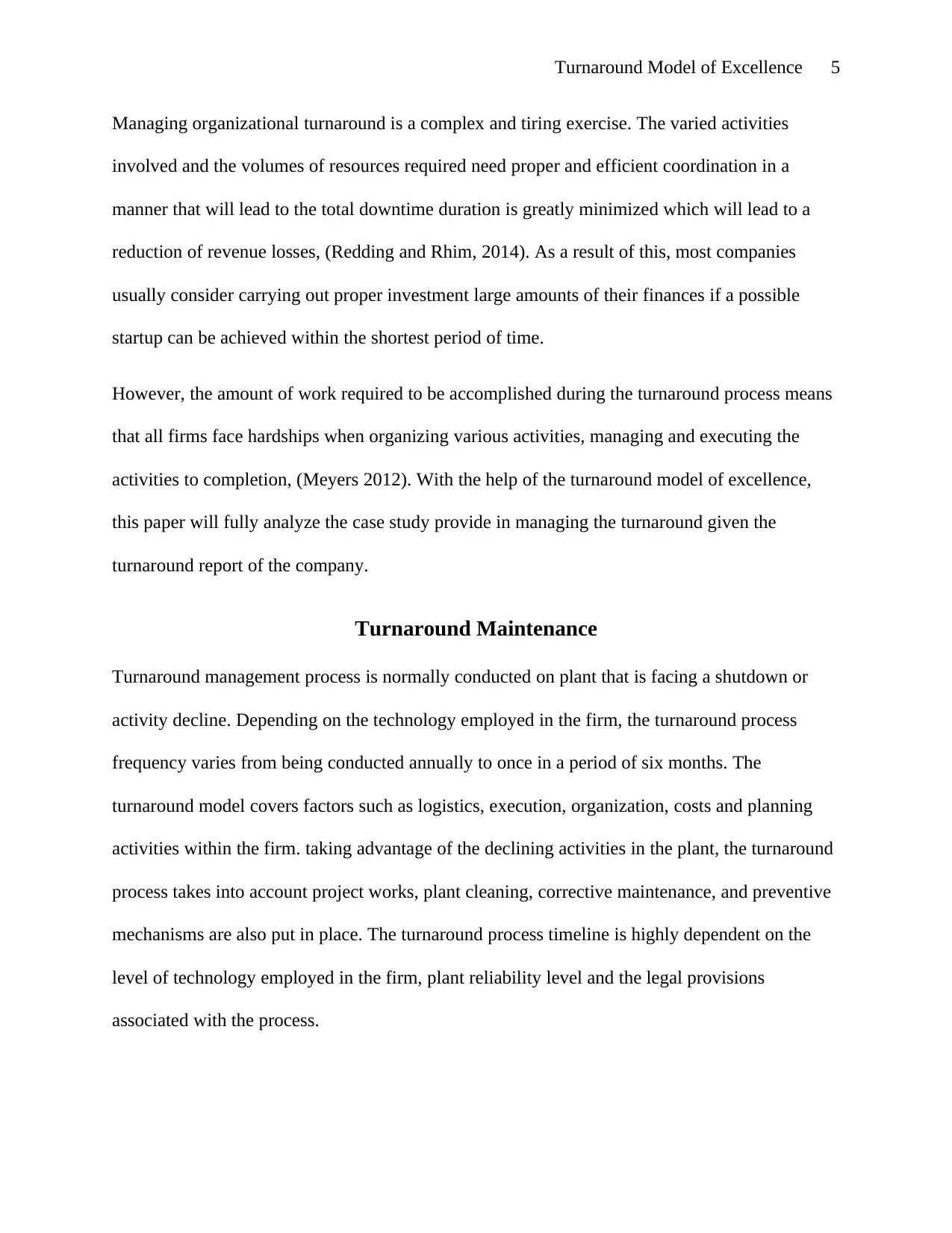
Turnaround Model of Excellence 5
Managing organizational turnaround is a complex and tiring exercise. The varied activities
involved and the volumes of resources required need proper and efficient coordination in a
manner that will lead to the total downtime duration is greatly minimized which will lead to a
reduction of revenue losses, (Redding and Rhim, 2014). As a result of this, most companies
usually consider carrying out proper investment large amounts of their finances if a possible
startup can be achieved within the shortest period of time.
However, the amount of work required to be accomplished during the turnaround process means
that all firms face hardships when organizing various activities, managing and executing the
activities to completion, (Meyers 2012). With the help of the turnaround model of excellence,
this paper will fully analyze the case study provide in managing the turnaround given the
turnaround report of the company.
Turnaround Maintenance
Turnaround management process is normally conducted on plant that is facing a shutdown or
activity decline. Depending on the technology employed in the firm, the turnaround process
frequency varies from being conducted annually to once in a period of six months. The
turnaround model covers factors such as logistics, execution, organization, costs and planning
activities within the firm. taking advantage of the declining activities in the plant, the turnaround
process takes into account project works, plant cleaning, corrective maintenance, and preventive
mechanisms are also put in place. The turnaround process timeline is highly dependent on the
level of technology employed in the firm, plant reliability level and the legal provisions
associated with the process.
Managing organizational turnaround is a complex and tiring exercise. The varied activities
involved and the volumes of resources required need proper and efficient coordination in a
manner that will lead to the total downtime duration is greatly minimized which will lead to a
reduction of revenue losses, (Redding and Rhim, 2014). As a result of this, most companies
usually consider carrying out proper investment large amounts of their finances if a possible
startup can be achieved within the shortest period of time.
However, the amount of work required to be accomplished during the turnaround process means
that all firms face hardships when organizing various activities, managing and executing the
activities to completion, (Meyers 2012). With the help of the turnaround model of excellence,
this paper will fully analyze the case study provide in managing the turnaround given the
turnaround report of the company.
Turnaround Maintenance
Turnaround management process is normally conducted on plant that is facing a shutdown or
activity decline. Depending on the technology employed in the firm, the turnaround process
frequency varies from being conducted annually to once in a period of six months. The
turnaround model covers factors such as logistics, execution, organization, costs and planning
activities within the firm. taking advantage of the declining activities in the plant, the turnaround
process takes into account project works, plant cleaning, corrective maintenance, and preventive
mechanisms are also put in place. The turnaround process timeline is highly dependent on the
level of technology employed in the firm, plant reliability level and the legal provisions
associated with the process.
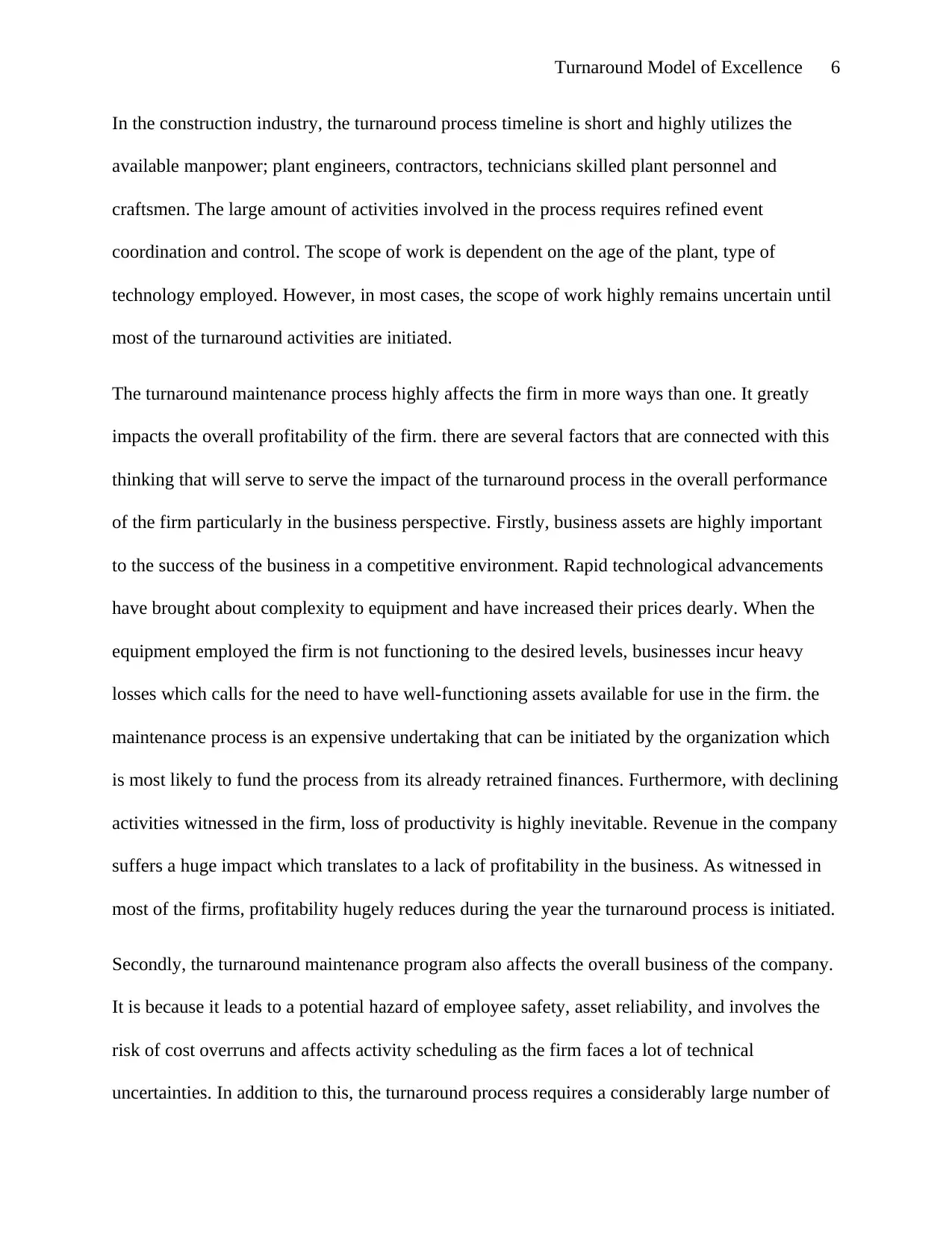
Turnaround Model of Excellence 6
In the construction industry, the turnaround process timeline is short and highly utilizes the
available manpower; plant engineers, contractors, technicians skilled plant personnel and
craftsmen. The large amount of activities involved in the process requires refined event
coordination and control. The scope of work is dependent on the age of the plant, type of
technology employed. However, in most cases, the scope of work highly remains uncertain until
most of the turnaround activities are initiated.
The turnaround maintenance process highly affects the firm in more ways than one. It greatly
impacts the overall profitability of the firm. there are several factors that are connected with this
thinking that will serve to serve the impact of the turnaround process in the overall performance
of the firm particularly in the business perspective. Firstly, business assets are highly important
to the success of the business in a competitive environment. Rapid technological advancements
have brought about complexity to equipment and have increased their prices dearly. When the
equipment employed the firm is not functioning to the desired levels, businesses incur heavy
losses which calls for the need to have well-functioning assets available for use in the firm. the
maintenance process is an expensive undertaking that can be initiated by the organization which
is most likely to fund the process from its already retrained finances. Furthermore, with declining
activities witnessed in the firm, loss of productivity is highly inevitable. Revenue in the company
suffers a huge impact which translates to a lack of profitability in the business. As witnessed in
most of the firms, profitability hugely reduces during the year the turnaround process is initiated.
Secondly, the turnaround maintenance program also affects the overall business of the company.
It is because it leads to a potential hazard of employee safety, asset reliability, and involves the
risk of cost overruns and affects activity scheduling as the firm faces a lot of technical
uncertainties. In addition to this, the turnaround process requires a considerably large number of
In the construction industry, the turnaround process timeline is short and highly utilizes the
available manpower; plant engineers, contractors, technicians skilled plant personnel and
craftsmen. The large amount of activities involved in the process requires refined event
coordination and control. The scope of work is dependent on the age of the plant, type of
technology employed. However, in most cases, the scope of work highly remains uncertain until
most of the turnaround activities are initiated.
The turnaround maintenance process highly affects the firm in more ways than one. It greatly
impacts the overall profitability of the firm. there are several factors that are connected with this
thinking that will serve to serve the impact of the turnaround process in the overall performance
of the firm particularly in the business perspective. Firstly, business assets are highly important
to the success of the business in a competitive environment. Rapid technological advancements
have brought about complexity to equipment and have increased their prices dearly. When the
equipment employed the firm is not functioning to the desired levels, businesses incur heavy
losses which calls for the need to have well-functioning assets available for use in the firm. the
maintenance process is an expensive undertaking that can be initiated by the organization which
is most likely to fund the process from its already retrained finances. Furthermore, with declining
activities witnessed in the firm, loss of productivity is highly inevitable. Revenue in the company
suffers a huge impact which translates to a lack of profitability in the business. As witnessed in
most of the firms, profitability hugely reduces during the year the turnaround process is initiated.
Secondly, the turnaround maintenance program also affects the overall business of the company.
It is because it leads to a potential hazard of employee safety, asset reliability, and involves the
risk of cost overruns and affects activity scheduling as the firm faces a lot of technical
uncertainties. In addition to this, the turnaround process requires a considerably large number of
⊘ This is a preview!⊘
Do you want full access?
Subscribe today to unlock all pages.

Trusted by 1+ million students worldwide
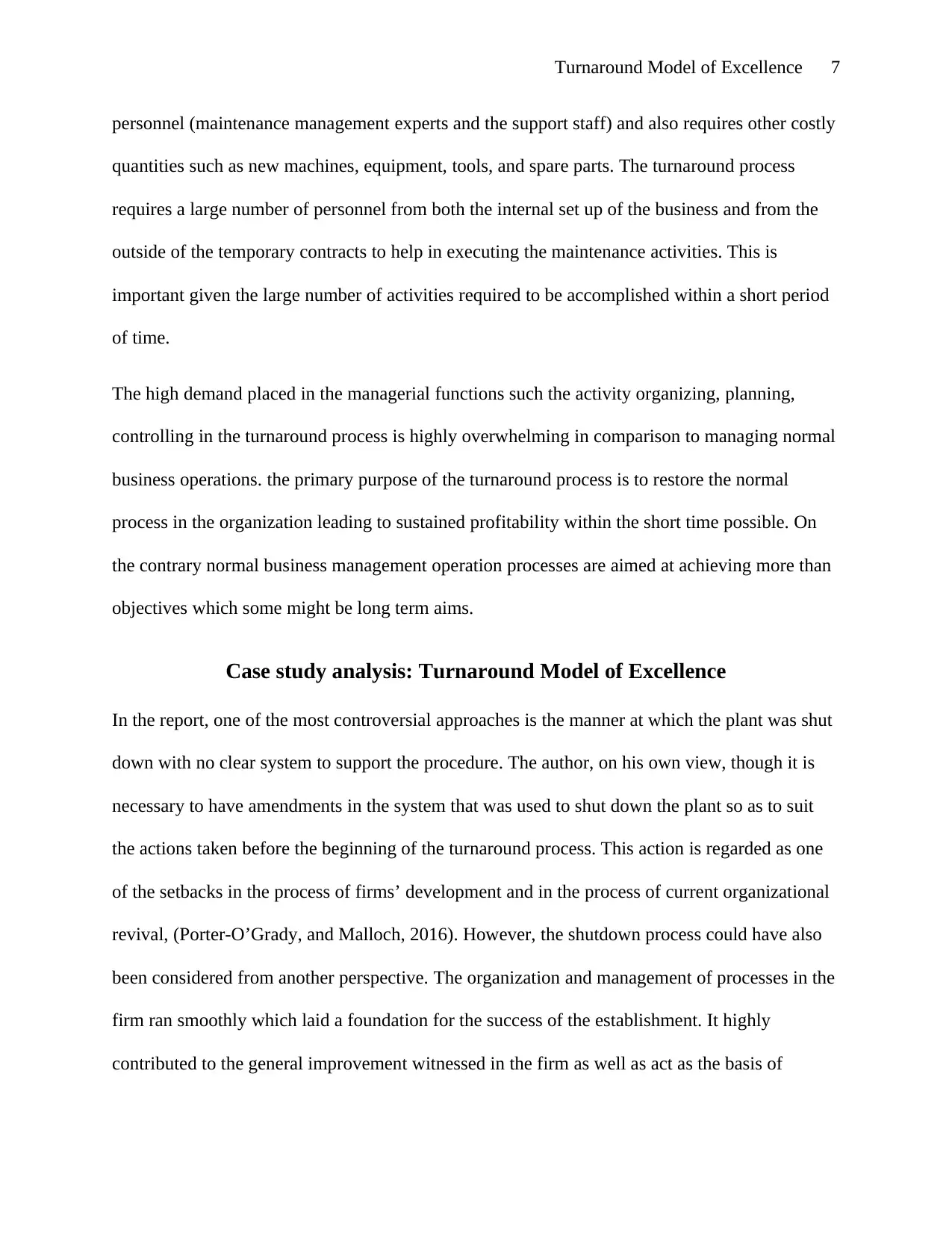
Turnaround Model of Excellence 7
personnel (maintenance management experts and the support staff) and also requires other costly
quantities such as new machines, equipment, tools, and spare parts. The turnaround process
requires a large number of personnel from both the internal set up of the business and from the
outside of the temporary contracts to help in executing the maintenance activities. This is
important given the large number of activities required to be accomplished within a short period
of time.
The high demand placed in the managerial functions such the activity organizing, planning,
controlling in the turnaround process is highly overwhelming in comparison to managing normal
business operations. the primary purpose of the turnaround process is to restore the normal
process in the organization leading to sustained profitability within the short time possible. On
the contrary normal business management operation processes are aimed at achieving more than
objectives which some might be long term aims.
Case study analysis: Turnaround Model of Excellence
In the report, one of the most controversial approaches is the manner at which the plant was shut
down with no clear system to support the procedure. The author, on his own view, though it is
necessary to have amendments in the system that was used to shut down the plant so as to suit
the actions taken before the beginning of the turnaround process. This action is regarded as one
of the setbacks in the process of firms’ development and in the process of current organizational
revival, (Porter-O’Grady, and Malloch, 2016). However, the shutdown process could have also
been considered from another perspective. The organization and management of processes in the
firm ran smoothly which laid a foundation for the success of the establishment. It highly
contributed to the general improvement witnessed in the firm as well as act as the basis of
personnel (maintenance management experts and the support staff) and also requires other costly
quantities such as new machines, equipment, tools, and spare parts. The turnaround process
requires a large number of personnel from both the internal set up of the business and from the
outside of the temporary contracts to help in executing the maintenance activities. This is
important given the large number of activities required to be accomplished within a short period
of time.
The high demand placed in the managerial functions such the activity organizing, planning,
controlling in the turnaround process is highly overwhelming in comparison to managing normal
business operations. the primary purpose of the turnaround process is to restore the normal
process in the organization leading to sustained profitability within the short time possible. On
the contrary normal business management operation processes are aimed at achieving more than
objectives which some might be long term aims.
Case study analysis: Turnaround Model of Excellence
In the report, one of the most controversial approaches is the manner at which the plant was shut
down with no clear system to support the procedure. The author, on his own view, though it is
necessary to have amendments in the system that was used to shut down the plant so as to suit
the actions taken before the beginning of the turnaround process. This action is regarded as one
of the setbacks in the process of firms’ development and in the process of current organizational
revival, (Porter-O’Grady, and Malloch, 2016). However, the shutdown process could have also
been considered from another perspective. The organization and management of processes in the
firm ran smoothly which laid a foundation for the success of the establishment. It highly
contributed to the general improvement witnessed in the firm as well as act as the basis of
Paraphrase This Document
Need a fresh take? Get an instant paraphrase of this document with our AI Paraphraser
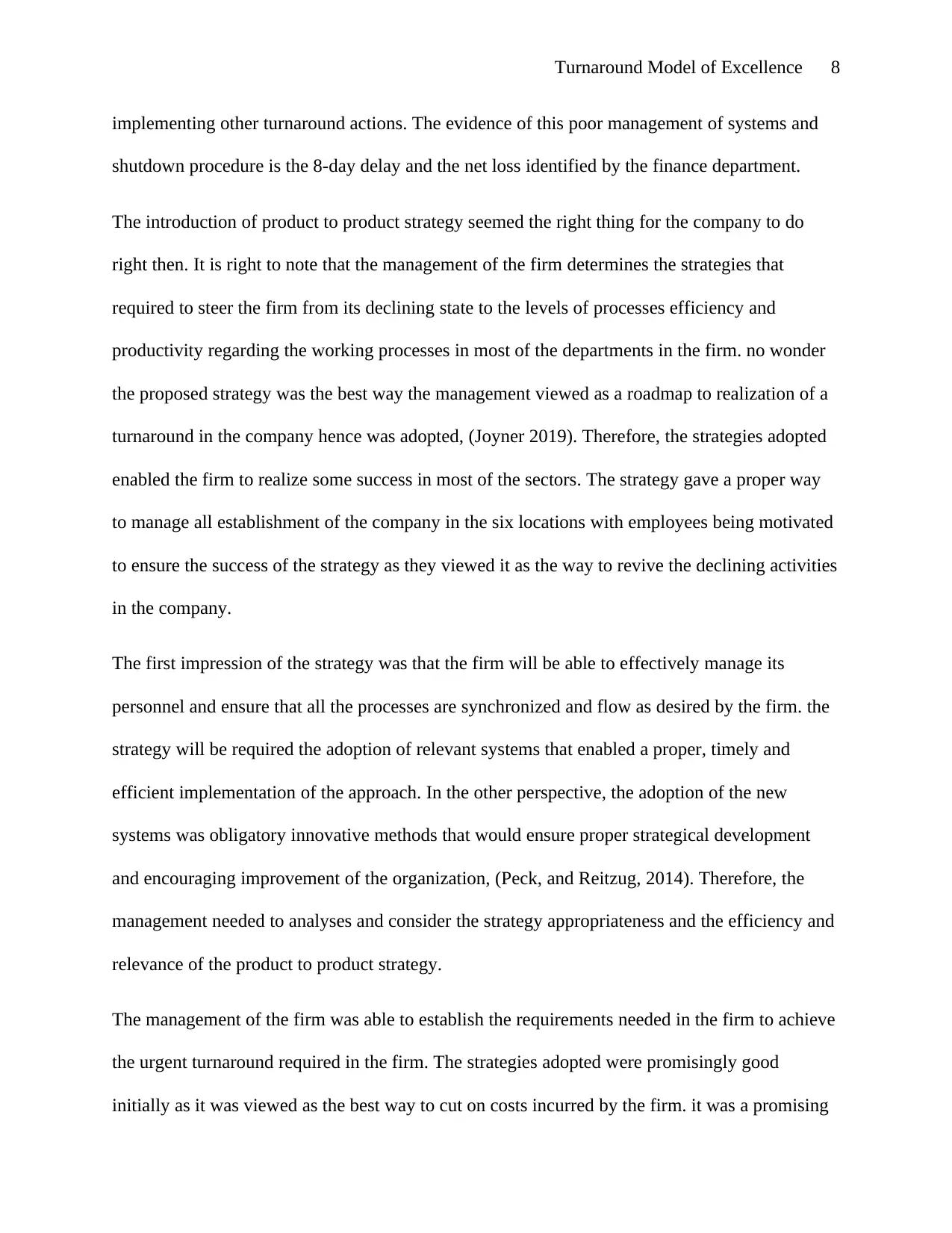
Turnaround Model of Excellence 8
implementing other turnaround actions. The evidence of this poor management of systems and
shutdown procedure is the 8-day delay and the net loss identified by the finance department.
The introduction of product to product strategy seemed the right thing for the company to do
right then. It is right to note that the management of the firm determines the strategies that
required to steer the firm from its declining state to the levels of processes efficiency and
productivity regarding the working processes in most of the departments in the firm. no wonder
the proposed strategy was the best way the management viewed as a roadmap to realization of a
turnaround in the company hence was adopted, (Joyner 2019). Therefore, the strategies adopted
enabled the firm to realize some success in most of the sectors. The strategy gave a proper way
to manage all establishment of the company in the six locations with employees being motivated
to ensure the success of the strategy as they viewed it as the way to revive the declining activities
in the company.
The first impression of the strategy was that the firm will be able to effectively manage its
personnel and ensure that all the processes are synchronized and flow as desired by the firm. the
strategy will be required the adoption of relevant systems that enabled a proper, timely and
efficient implementation of the approach. In the other perspective, the adoption of the new
systems was obligatory innovative methods that would ensure proper strategical development
and encouraging improvement of the organization, (Peck, and Reitzug, 2014). Therefore, the
management needed to analyses and consider the strategy appropriateness and the efficiency and
relevance of the product to product strategy.
The management of the firm was able to establish the requirements needed in the firm to achieve
the urgent turnaround required in the firm. The strategies adopted were promisingly good
initially as it was viewed as the best way to cut on costs incurred by the firm. it was a promising
implementing other turnaround actions. The evidence of this poor management of systems and
shutdown procedure is the 8-day delay and the net loss identified by the finance department.
The introduction of product to product strategy seemed the right thing for the company to do
right then. It is right to note that the management of the firm determines the strategies that
required to steer the firm from its declining state to the levels of processes efficiency and
productivity regarding the working processes in most of the departments in the firm. no wonder
the proposed strategy was the best way the management viewed as a roadmap to realization of a
turnaround in the company hence was adopted, (Joyner 2019). Therefore, the strategies adopted
enabled the firm to realize some success in most of the sectors. The strategy gave a proper way
to manage all establishment of the company in the six locations with employees being motivated
to ensure the success of the strategy as they viewed it as the way to revive the declining activities
in the company.
The first impression of the strategy was that the firm will be able to effectively manage its
personnel and ensure that all the processes are synchronized and flow as desired by the firm. the
strategy will be required the adoption of relevant systems that enabled a proper, timely and
efficient implementation of the approach. In the other perspective, the adoption of the new
systems was obligatory innovative methods that would ensure proper strategical development
and encouraging improvement of the organization, (Peck, and Reitzug, 2014). Therefore, the
management needed to analyses and consider the strategy appropriateness and the efficiency and
relevance of the product to product strategy.
The management of the firm was able to establish the requirements needed in the firm to achieve
the urgent turnaround required in the firm. The strategies adopted were promisingly good
initially as it was viewed as the best way to cut on costs incurred by the firm. it was a promising
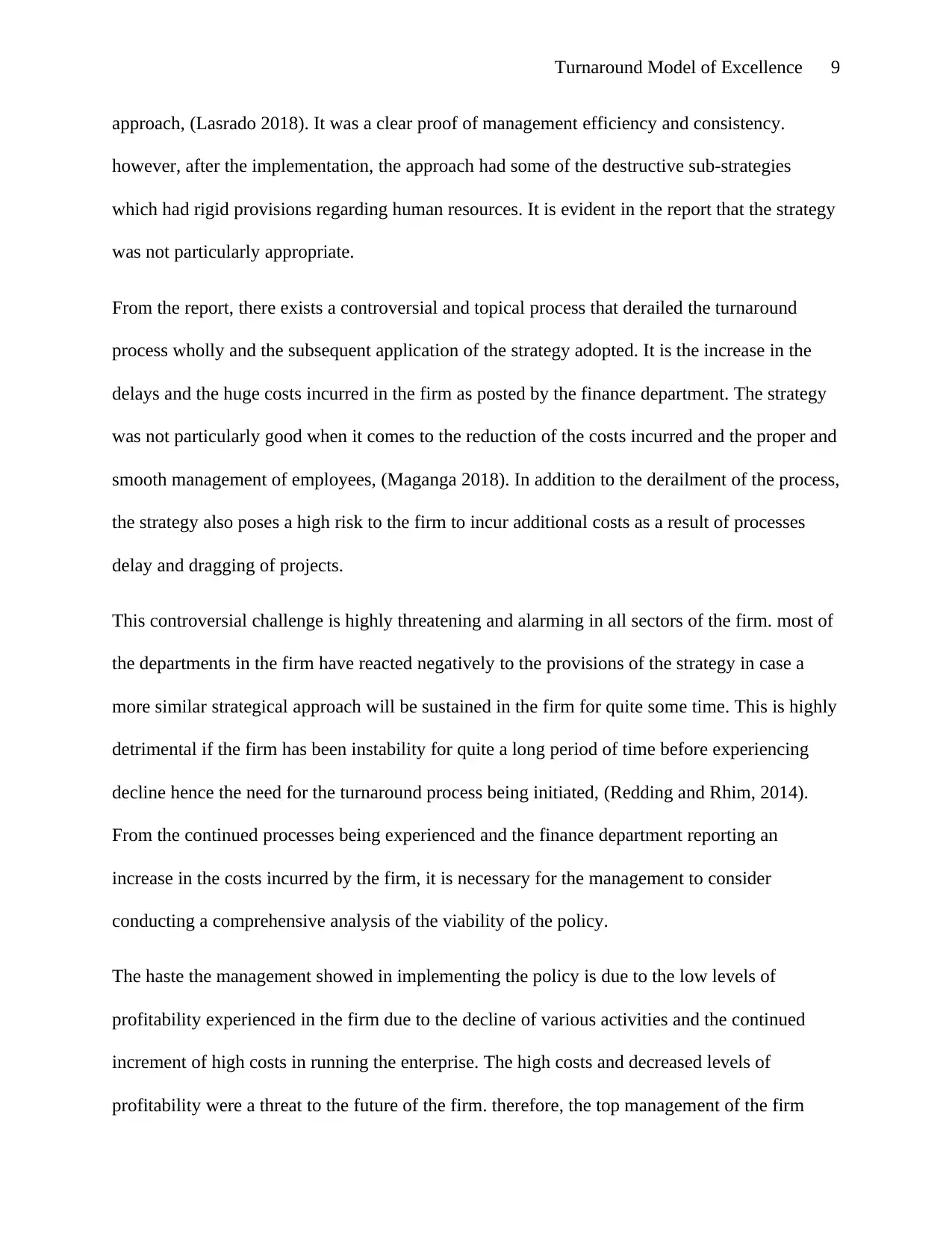
Turnaround Model of Excellence 9
approach, (Lasrado 2018). It was a clear proof of management efficiency and consistency.
however, after the implementation, the approach had some of the destructive sub-strategies
which had rigid provisions regarding human resources. It is evident in the report that the strategy
was not particularly appropriate.
From the report, there exists a controversial and topical process that derailed the turnaround
process wholly and the subsequent application of the strategy adopted. It is the increase in the
delays and the huge costs incurred in the firm as posted by the finance department. The strategy
was not particularly good when it comes to the reduction of the costs incurred and the proper and
smooth management of employees, (Maganga 2018). In addition to the derailment of the process,
the strategy also poses a high risk to the firm to incur additional costs as a result of processes
delay and dragging of projects.
This controversial challenge is highly threatening and alarming in all sectors of the firm. most of
the departments in the firm have reacted negatively to the provisions of the strategy in case a
more similar strategical approach will be sustained in the firm for quite some time. This is highly
detrimental if the firm has been instability for quite a long period of time before experiencing
decline hence the need for the turnaround process being initiated, (Redding and Rhim, 2014).
From the continued processes being experienced and the finance department reporting an
increase in the costs incurred by the firm, it is necessary for the management to consider
conducting a comprehensive analysis of the viability of the policy.
The haste the management showed in implementing the policy is due to the low levels of
profitability experienced in the firm due to the decline of various activities and the continued
increment of high costs in running the enterprise. The high costs and decreased levels of
profitability were a threat to the future of the firm. therefore, the top management of the firm
approach, (Lasrado 2018). It was a clear proof of management efficiency and consistency.
however, after the implementation, the approach had some of the destructive sub-strategies
which had rigid provisions regarding human resources. It is evident in the report that the strategy
was not particularly appropriate.
From the report, there exists a controversial and topical process that derailed the turnaround
process wholly and the subsequent application of the strategy adopted. It is the increase in the
delays and the huge costs incurred in the firm as posted by the finance department. The strategy
was not particularly good when it comes to the reduction of the costs incurred and the proper and
smooth management of employees, (Maganga 2018). In addition to the derailment of the process,
the strategy also poses a high risk to the firm to incur additional costs as a result of processes
delay and dragging of projects.
This controversial challenge is highly threatening and alarming in all sectors of the firm. most of
the departments in the firm have reacted negatively to the provisions of the strategy in case a
more similar strategical approach will be sustained in the firm for quite some time. This is highly
detrimental if the firm has been instability for quite a long period of time before experiencing
decline hence the need for the turnaround process being initiated, (Redding and Rhim, 2014).
From the continued processes being experienced and the finance department reporting an
increase in the costs incurred by the firm, it is necessary for the management to consider
conducting a comprehensive analysis of the viability of the policy.
The haste the management showed in implementing the policy is due to the low levels of
profitability experienced in the firm due to the decline of various activities and the continued
increment of high costs in running the enterprise. The high costs and decreased levels of
profitability were a threat to the future of the firm. therefore, the top management of the firm
⊘ This is a preview!⊘
Do you want full access?
Subscribe today to unlock all pages.

Trusted by 1+ million students worldwide
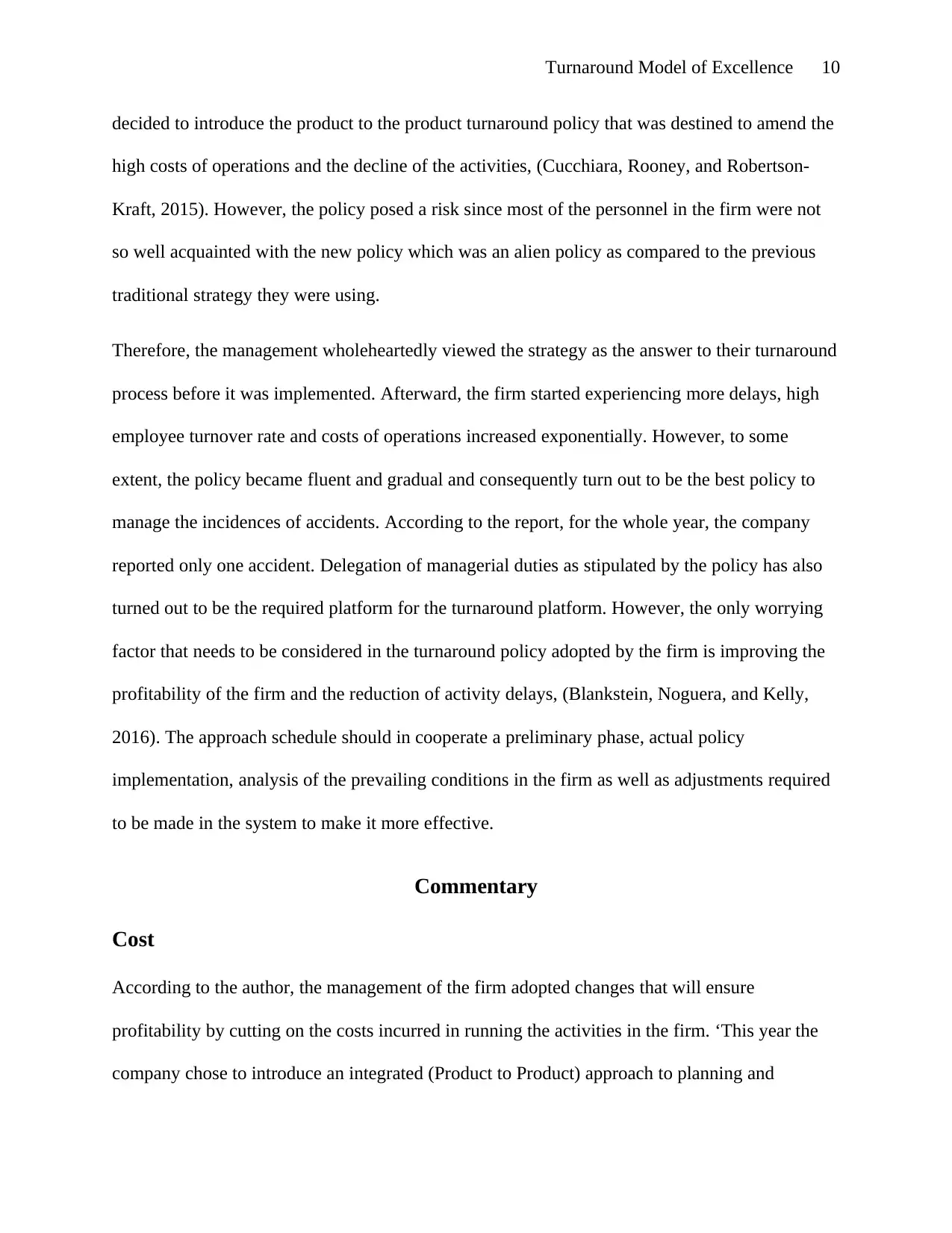
Turnaround Model of Excellence 10
decided to introduce the product to the product turnaround policy that was destined to amend the
high costs of operations and the decline of the activities, (Cucchiara, Rooney, and Robertson-
Kraft, 2015). However, the policy posed a risk since most of the personnel in the firm were not
so well acquainted with the new policy which was an alien policy as compared to the previous
traditional strategy they were using.
Therefore, the management wholeheartedly viewed the strategy as the answer to their turnaround
process before it was implemented. Afterward, the firm started experiencing more delays, high
employee turnover rate and costs of operations increased exponentially. However, to some
extent, the policy became fluent and gradual and consequently turn out to be the best policy to
manage the incidences of accidents. According to the report, for the whole year, the company
reported only one accident. Delegation of managerial duties as stipulated by the policy has also
turned out to be the required platform for the turnaround platform. However, the only worrying
factor that needs to be considered in the turnaround policy adopted by the firm is improving the
profitability of the firm and the reduction of activity delays, (Blankstein, Noguera, and Kelly,
2016). The approach schedule should in cooperate a preliminary phase, actual policy
implementation, analysis of the prevailing conditions in the firm as well as adjustments required
to be made in the system to make it more effective.
Commentary
Cost
According to the author, the management of the firm adopted changes that will ensure
profitability by cutting on the costs incurred in running the activities in the firm. ‘This year the
company chose to introduce an integrated (Product to Product) approach to planning and
decided to introduce the product to the product turnaround policy that was destined to amend the
high costs of operations and the decline of the activities, (Cucchiara, Rooney, and Robertson-
Kraft, 2015). However, the policy posed a risk since most of the personnel in the firm were not
so well acquainted with the new policy which was an alien policy as compared to the previous
traditional strategy they were using.
Therefore, the management wholeheartedly viewed the strategy as the answer to their turnaround
process before it was implemented. Afterward, the firm started experiencing more delays, high
employee turnover rate and costs of operations increased exponentially. However, to some
extent, the policy became fluent and gradual and consequently turn out to be the best policy to
manage the incidences of accidents. According to the report, for the whole year, the company
reported only one accident. Delegation of managerial duties as stipulated by the policy has also
turned out to be the required platform for the turnaround platform. However, the only worrying
factor that needs to be considered in the turnaround policy adopted by the firm is improving the
profitability of the firm and the reduction of activity delays, (Blankstein, Noguera, and Kelly,
2016). The approach schedule should in cooperate a preliminary phase, actual policy
implementation, analysis of the prevailing conditions in the firm as well as adjustments required
to be made in the system to make it more effective.
Commentary
Cost
According to the author, the management of the firm adopted changes that will ensure
profitability by cutting on the costs incurred in running the activities in the firm. ‘This year the
company chose to introduce an integrated (Product to Product) approach to planning and
Paraphrase This Document
Need a fresh take? Get an instant paraphrase of this document with our AI Paraphraser
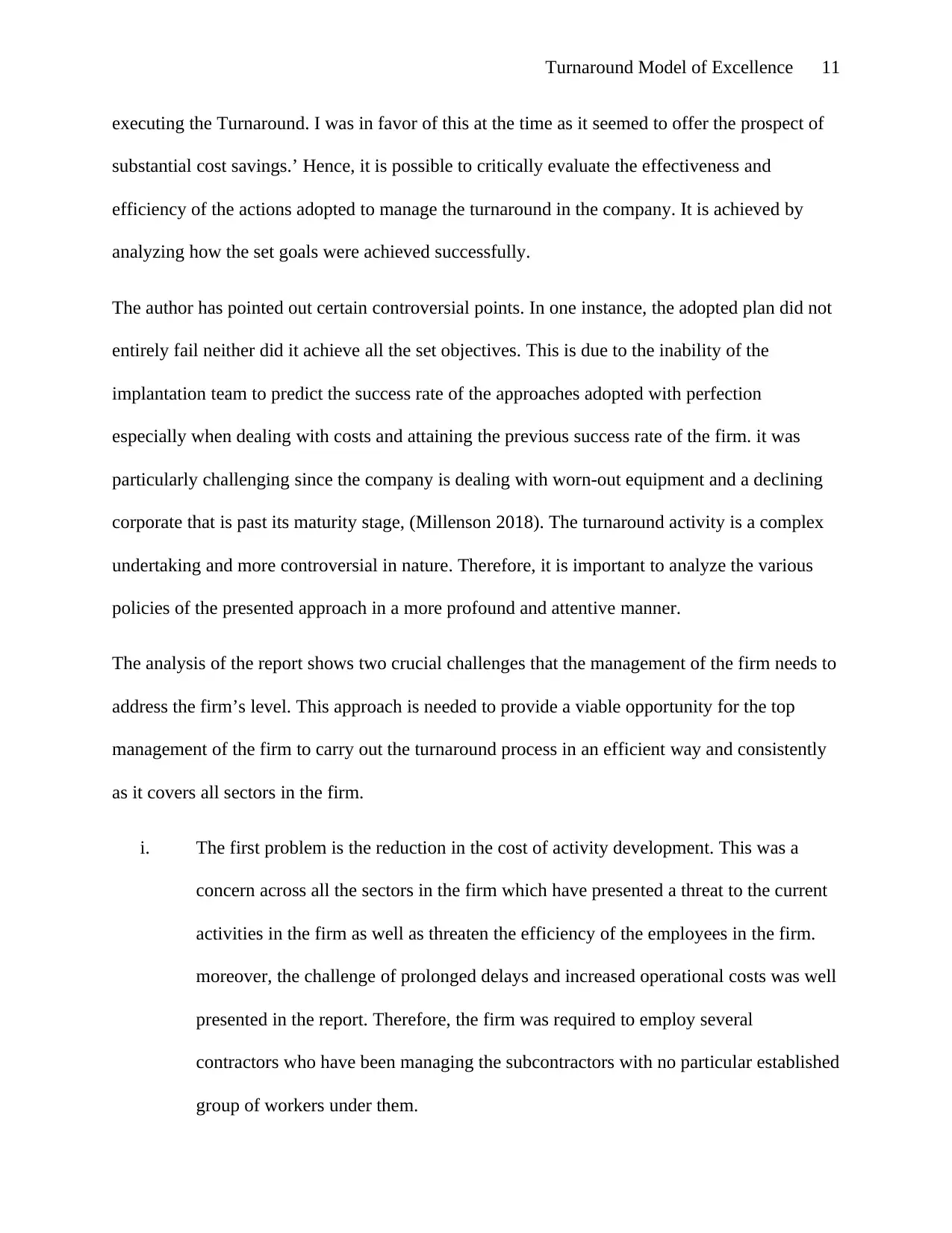
Turnaround Model of Excellence 11
executing the Turnaround. I was in favor of this at the time as it seemed to offer the prospect of
substantial cost savings.’ Hence, it is possible to critically evaluate the effectiveness and
efficiency of the actions adopted to manage the turnaround in the company. It is achieved by
analyzing how the set goals were achieved successfully.
The author has pointed out certain controversial points. In one instance, the adopted plan did not
entirely fail neither did it achieve all the set objectives. This is due to the inability of the
implantation team to predict the success rate of the approaches adopted with perfection
especially when dealing with costs and attaining the previous success rate of the firm. it was
particularly challenging since the company is dealing with worn-out equipment and a declining
corporate that is past its maturity stage, (Millenson 2018). The turnaround activity is a complex
undertaking and more controversial in nature. Therefore, it is important to analyze the various
policies of the presented approach in a more profound and attentive manner.
The analysis of the report shows two crucial challenges that the management of the firm needs to
address the firm’s level. This approach is needed to provide a viable opportunity for the top
management of the firm to carry out the turnaround process in an efficient way and consistently
as it covers all sectors in the firm.
i. The first problem is the reduction in the cost of activity development. This was a
concern across all the sectors in the firm which have presented a threat to the current
activities in the firm as well as threaten the efficiency of the employees in the firm.
moreover, the challenge of prolonged delays and increased operational costs was well
presented in the report. Therefore, the firm was required to employ several
contractors who have been managing the subcontractors with no particular established
group of workers under them.
executing the Turnaround. I was in favor of this at the time as it seemed to offer the prospect of
substantial cost savings.’ Hence, it is possible to critically evaluate the effectiveness and
efficiency of the actions adopted to manage the turnaround in the company. It is achieved by
analyzing how the set goals were achieved successfully.
The author has pointed out certain controversial points. In one instance, the adopted plan did not
entirely fail neither did it achieve all the set objectives. This is due to the inability of the
implantation team to predict the success rate of the approaches adopted with perfection
especially when dealing with costs and attaining the previous success rate of the firm. it was
particularly challenging since the company is dealing with worn-out equipment and a declining
corporate that is past its maturity stage, (Millenson 2018). The turnaround activity is a complex
undertaking and more controversial in nature. Therefore, it is important to analyze the various
policies of the presented approach in a more profound and attentive manner.
The analysis of the report shows two crucial challenges that the management of the firm needs to
address the firm’s level. This approach is needed to provide a viable opportunity for the top
management of the firm to carry out the turnaround process in an efficient way and consistently
as it covers all sectors in the firm.
i. The first problem is the reduction in the cost of activity development. This was a
concern across all the sectors in the firm which have presented a threat to the current
activities in the firm as well as threaten the efficiency of the employees in the firm.
moreover, the challenge of prolonged delays and increased operational costs was well
presented in the report. Therefore, the firm was required to employ several
contractors who have been managing the subcontractors with no particular established
group of workers under them.
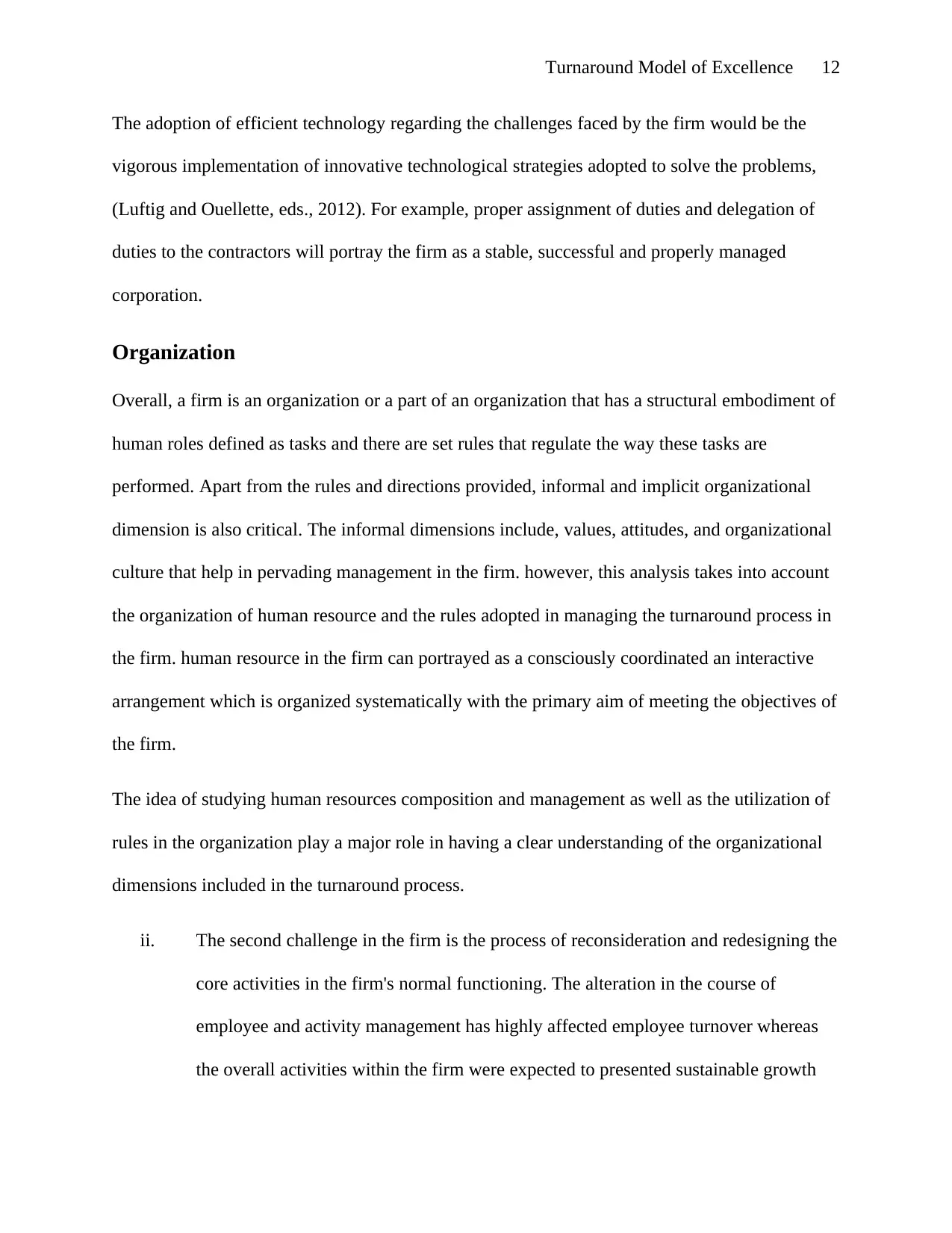
Turnaround Model of Excellence 12
The adoption of efficient technology regarding the challenges faced by the firm would be the
vigorous implementation of innovative technological strategies adopted to solve the problems,
(Luftig and Ouellette, eds., 2012). For example, proper assignment of duties and delegation of
duties to the contractors will portray the firm as a stable, successful and properly managed
corporation.
Organization
Overall, a firm is an organization or a part of an organization that has a structural embodiment of
human roles defined as tasks and there are set rules that regulate the way these tasks are
performed. Apart from the rules and directions provided, informal and implicit organizational
dimension is also critical. The informal dimensions include, values, attitudes, and organizational
culture that help in pervading management in the firm. however, this analysis takes into account
the organization of human resource and the rules adopted in managing the turnaround process in
the firm. human resource in the firm can portrayed as a consciously coordinated an interactive
arrangement which is organized systematically with the primary aim of meeting the objectives of
the firm.
The idea of studying human resources composition and management as well as the utilization of
rules in the organization play a major role in having a clear understanding of the organizational
dimensions included in the turnaround process.
ii. The second challenge in the firm is the process of reconsideration and redesigning the
core activities in the firm's normal functioning. The alteration in the course of
employee and activity management has highly affected employee turnover whereas
the overall activities within the firm were expected to presented sustainable growth
The adoption of efficient technology regarding the challenges faced by the firm would be the
vigorous implementation of innovative technological strategies adopted to solve the problems,
(Luftig and Ouellette, eds., 2012). For example, proper assignment of duties and delegation of
duties to the contractors will portray the firm as a stable, successful and properly managed
corporation.
Organization
Overall, a firm is an organization or a part of an organization that has a structural embodiment of
human roles defined as tasks and there are set rules that regulate the way these tasks are
performed. Apart from the rules and directions provided, informal and implicit organizational
dimension is also critical. The informal dimensions include, values, attitudes, and organizational
culture that help in pervading management in the firm. however, this analysis takes into account
the organization of human resource and the rules adopted in managing the turnaround process in
the firm. human resource in the firm can portrayed as a consciously coordinated an interactive
arrangement which is organized systematically with the primary aim of meeting the objectives of
the firm.
The idea of studying human resources composition and management as well as the utilization of
rules in the organization play a major role in having a clear understanding of the organizational
dimensions included in the turnaround process.
ii. The second challenge in the firm is the process of reconsideration and redesigning the
core activities in the firm's normal functioning. The alteration in the course of
employee and activity management has highly affected employee turnover whereas
the overall activities within the firm were expected to presented sustainable growth
⊘ This is a preview!⊘
Do you want full access?
Subscribe today to unlock all pages.

Trusted by 1+ million students worldwide
1 out of 26
Related Documents
Your All-in-One AI-Powered Toolkit for Academic Success.
+13062052269
info@desklib.com
Available 24*7 on WhatsApp / Email
![[object Object]](/_next/static/media/star-bottom.7253800d.svg)
Unlock your academic potential
Copyright © 2020–2025 A2Z Services. All Rights Reserved. Developed and managed by ZUCOL.





